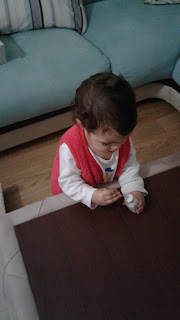13th and 14th Month Activities
A latest collection of our 13th month activities is here :
You can teach animal name and sound with such an activity that; surround each animal figure with folio. Then show one to your baby how to unfold it. When she unfolds each pack, she will get surprised when she sees the animals in it. For each animal, you can tell their name, properties, such as it has 2 feet, 2 ears, and show its sound. And also, if you are raising a bilingual kid, you can tell all these thing in a second language to increase the number of words.
- Put some rings on roasting jack.
- Trying to take an object out of the box.

- Put toothpicks in a hole.
- Play with colorful objects in the water.


- Peeling eggs tangerine, banana, etc.
- Stick and take back:


- Color basket: Each day or week, a basket is filled of objects with the same color.
- Trials to built a tower
- Playing with water and sponge
- Throwing balls

- Putting some different materials, such as rice, water .
- Playing with food
- Turn on-off the light
- Throwing a pompom into a bottle with a whole and taking back.
- Meeting some different treasures, such as towel, sponge, napkin, etc.
- Playing with fingerpainting
- Playing with the tap and water.
- Matching the animal cards with animal toys.
- Trials to play ball
- Daily life routines
- Put the sticks in the whole
- Sensorial Bottles
- Throwing the ball
- Spotting the animals
15th Month Montessori Activities
A summary:
- Raisin transfer activity.
The objects shold be transferred by hand at first, then by spoon.
The reason for choosing raisin is to make my baby eat something beneficial during activity.
- Playing with a mix of farina and oil and then transferring it by spoon
- Reading book time. Talking about the pictures and ask the baby to show some objects in the picture.
- Building tower with cubes










































Comments
Post a Comment